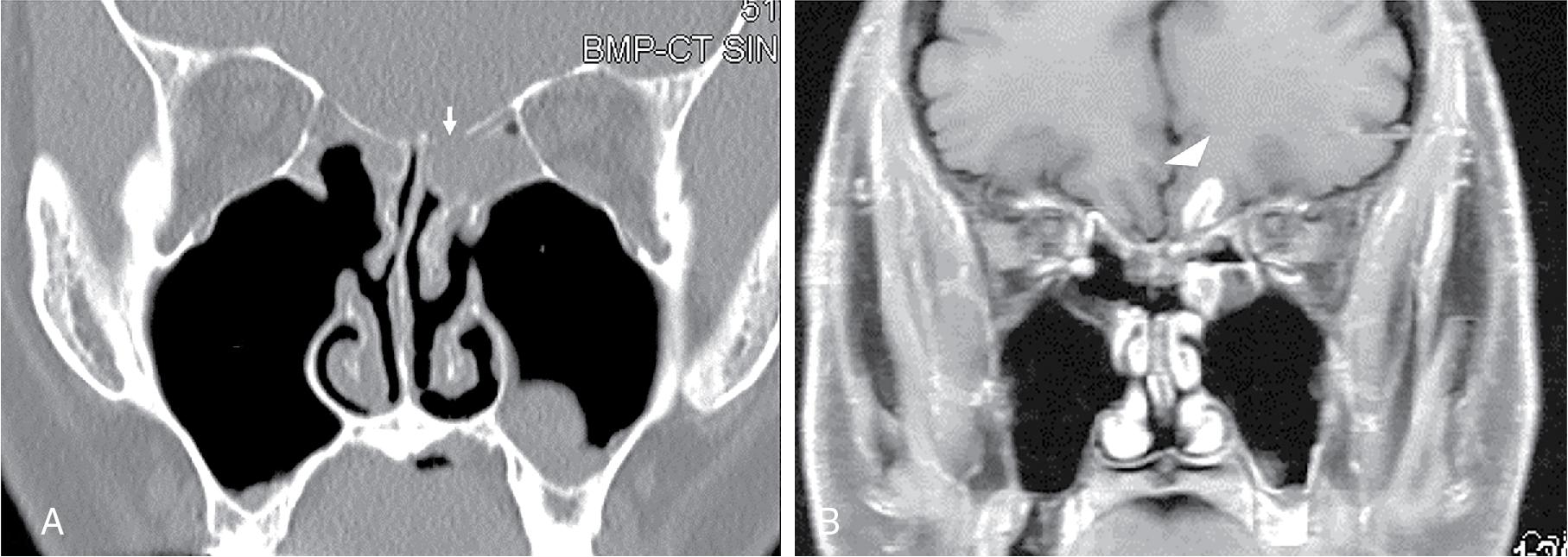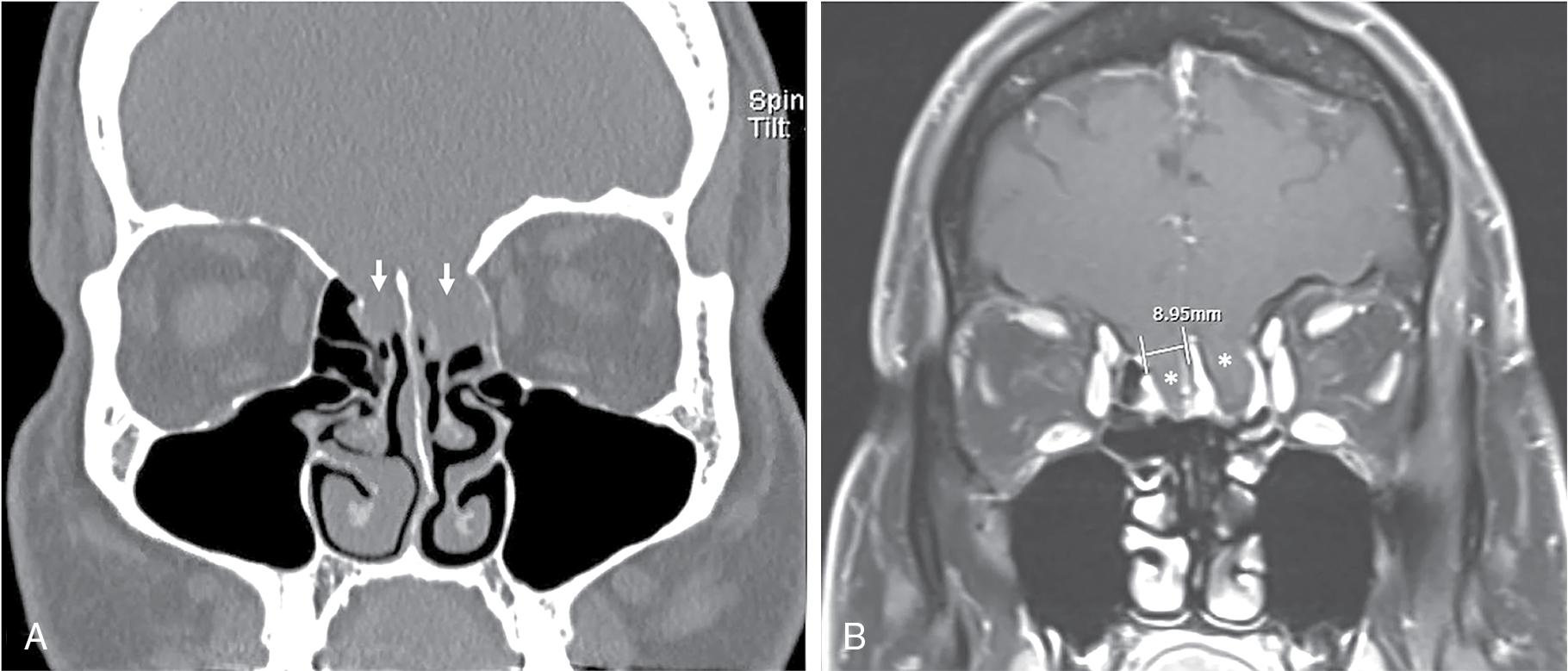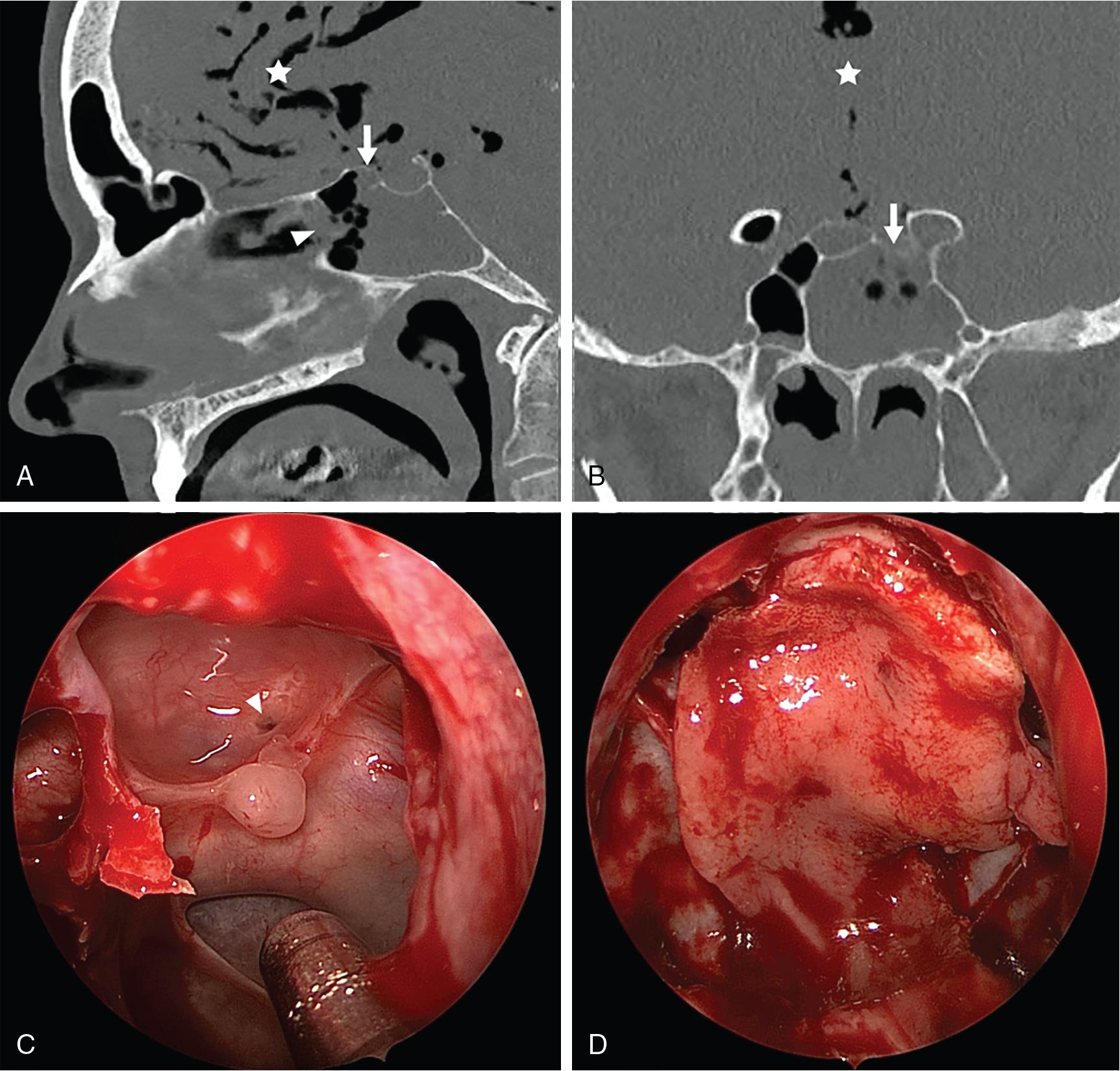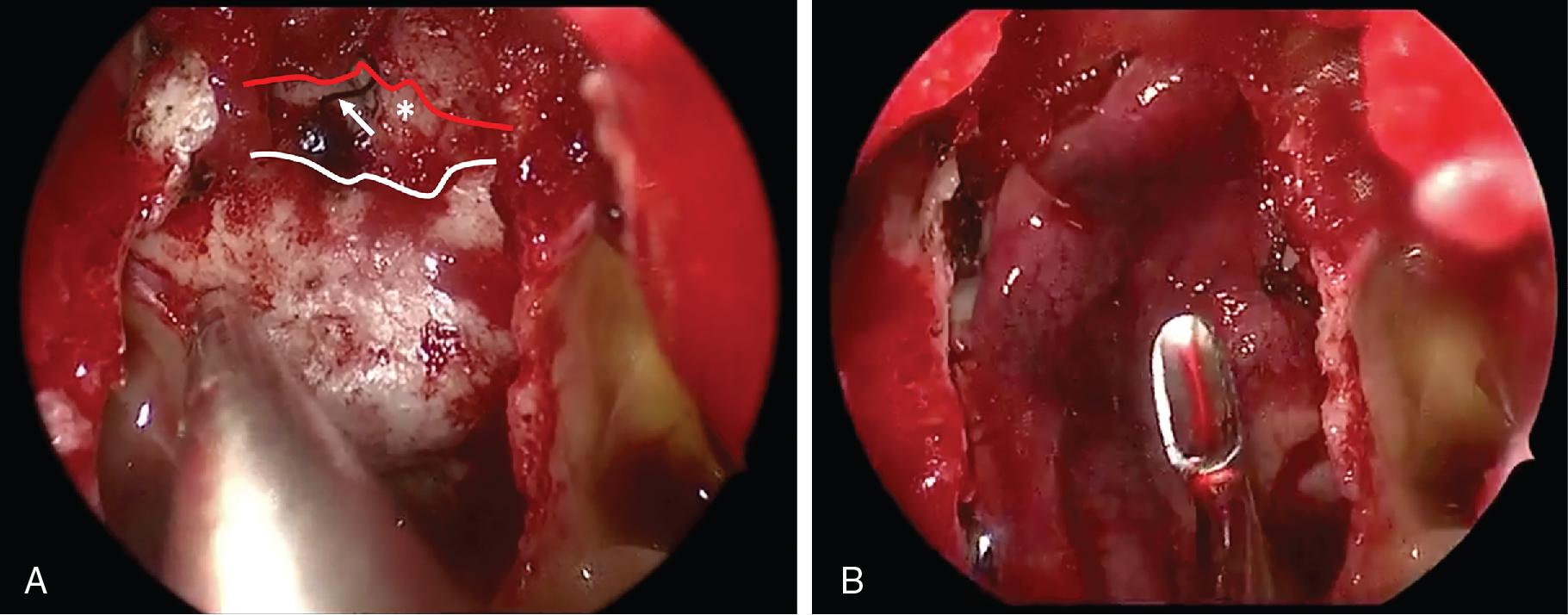Physical Address
304 North Cardinal St.
Dorchester Center, MA 02124
Cerebrospinal fluid (CSF) rhinorrhea results from a breach in the skull base, leading to communication between the subarachnoid space and nasal cavity. The accurate classification of CSF leak etiology is paramount because this information often guides management. An in-depth discussion regarding categorization of CSF rhinorrhea can be found in Chapter 1 , but broadly speaking, there are traumatic and nontraumatic causes. Traumatic causes can be further divided into noniatrogenic injury versus iatrogenic injury; the focus here is the latter.
Iatrogenic CSF rhinorrhea results from injury (often unintentional) of the skull base during rhinologic or neurosurgical procedures. Endoscopic sinus surgery (ESS) and septoplasty are the most common rhinologic procedures resulting in iatrogenic injury. Similarly, endonasal and open neurosurgical approaches for anterior skull base pathology may result in injury. Although pituitary surgery and skull base tumor resections frequently result in iatrogenic skull base defects, reconstruction of these defects is discussed in their dedicated sections (see Chapters 31 and 33 ).
Historically, traumatic leaks accounted for 80% to 90% of CSF fistulae. However, more recent systematic reviews note a significant increase in the proportion of spontaneous CSF rhinorrhea. Contemporary studies estimate comparable rates of traumatic and nontraumatic causes. This rise in proportion of spontaneous CSF rhinorrhea is likely attributable to a combination of factors, including rising rates of obesity worldwide because obesity is an established risk factor for idiopathic intracranial hypertension.
Among traumatic leaks, the most common iatrogenic injury resulting in CSF rhinorrhea occurs in the setting of ESS. Historic studies from the 1990s reported rates of major complications after ESS in the range of 2%, and as expected, improved outcomes were associated with increased surgeon experience. With time, these rates have decreased, likely because of improved technology, improved surgical techniques, and a better understanding of sinonasal anatomy. Contemporary studies suggest that rates of major complications range from 0.3% to 0.5%, with the rate of skull base complications specifically ranging from 0.1% to 0.3%.
Factors that may increase risk of skull base injury during ESS include cases involving older patients or complex cases involving more extensive sinus operations, such as revision sinus procedures. Additionally, poor insurance has been shown to be a risk factor for injury, but this likely serves as a proxy for broader access to care issues. Interestingly, pediatric cases, which have narrower surgical corridors, do not demonstrate increased risk of skull base complications. This may be a result of more conservative management of sinonasal and anterior skull base pathologies in the pediatric population. It is important to note that surgical navigation does not appear to decrease rates of skull base injury, but many practitioners find it to be a useful tool that increases surgeon confidence, particularly in complex and in revision surgical settings.
Iatrogenic injuries can result from any procedure (endoscopic or open) involving instrumentation along the skull base. CSF rhinorrhea results from a full- thickness defect involving the mucosa, periosteum, bone, dura, and arachnoid mater, leading to communication of the subarachnoid space with the nasal cavity. This communication results in presenting symptoms that commonly include unilateral continuous rhinorrhea exacerbated by head positioning and Valsalva maneuver. CSF fistulae increases the risk of an ascending bacterial infection that can result in complications such as pneumocephalus, meningitis, and epidural abscesses. In unfortunate instances, patients can present with these complications and symptoms can include signs of systemic infection (e.g., fevers, nausea, vomiting), severe headache, neck stiffness, and altered mental status. Unlike other forms of CSF rhinorrhea such as spontaneous leaks, intracranial pressures are frequently within normal limits in the setting of iatrogenic injury.
The subsequent discussions focus on iatrogenic injury in the setting of rhinologic or neurosurgical procedures and the locations of iatrogenic injuries. Localization is integral to successful management and repair of the defect. The goal of these discussions is to assist the skull base surgeon in thinking through possible areas of injury.
The most common rhinologic procedure leading to iatrogenic CSF rhinorrhea is ESS, and the most common site for iatrogenic injury is the ethmoid skull base ( Table 12.1 ). Within the ethmoid skull base, the lateral lamella has been cited as the most frequent and vulnerable location of injury given its relative thinness compared to other regions of the anterior skull base. , The Keros classification system was developed to stratify risk of lateral lamella injury. This classification system highlights the importance of performing a critical preoperative computed tomography (CT) scan review to closely inspect the skull base for areas at risk of injury. A lateral lamella measuring greater than 7 mm falls into the highest Keros classification (Keros 3) and is suspected to be at highest risk of injury. Keros 1 and Keros 2 refer to lateral lamella measuring 1 to 3 mm and 3 to 7 mm, respectively. Other factors that may increase risk of skull base injury (and should be noted on preoperative imaging review) are skull base dehiscence and asymmetries. The posterior ethmoid skull base in the region of the ethmoid roof is another notable area for iatrogenic injury. Moving from anterior to posterior, the anterior skull base slopes inferiorly, explaining why the skull base is susceptible to injury in the posterior ethmoid cavity. Early in the history of ESS, there were likely a greater number of injuries in this region, and this likely led to a gradual change in technique wherein the posterior ethmoid compartment was entered low, and the sphenoid sinus and skull base were identified before skeletonizing the ethmoid skull base in a posterior-to-anterior direction under clear visualization. Again, careful preoperative CT review and identification of a narrow posterior ethmoid compartment (i.e., low posterior ethmoid height) or dehiscence in this region may prevent injury in this location. Fig. 12.1 shows a classic iatrogenic ethmoid roof defect with associated intracranial injury.
| Study and Year | Ethmoid Skull Base | Sphenoid Skull Base | Frontal Recess |
|---|---|---|---|
| Lee et al. (2011) |
|
8 (40%) | 4 (20%) |
| Banks et al. (2009) |
|
2 (5%) | 4 (11%) |
| Bumm et al. (2009) |
|
7 (23%) | 6 (20%) |
| Tabaee et al. (2005) |
|
6 (25%) | 0 (0%) |
| Total | 106 (74%) | 23 (16%) | 14 (10%) |

After the ethmoid roof, the sphenoid skull base and planum sphenoidale have been cited as the next most common locations of iatrogenic injury in ESS (see Table 12.1 ). During endonasal surgery, clearly identifying the natural sphenoid os and avoiding blind entry through the anterior face of the sphenoid sinus may minimize the risk of injury to the sphenoid skull base. The sphenoid os is located in a consistent location medial to the superior turbinate, lateral to the nasal septum, and below the skull base. In revision settings, the arch of the choana and the roof of the maxillary sinus (i.e., orbital floor) are useful anatomic landmarks that can aid in identification of the natural sphenoid os. The natural sphenoid os is approximately 15 mm above the arch of the choana and at the level of the roof of the maxillary sinus (usually never higher). Frequently, the natural sphenoid os can be identified on preoperative CT review. It is also important to make note of the presence of Onodi cells, which are posterior ethmoid cells located superior to and that extend posterior to the face of the sphenoid sinus. They frequently contain the opticocarotid recess, and studies have noted higher rates of optic nerve dehiscence in settings of Onodi cells. The presence of an Onodi cells can be disorienting, and recognition of this anatomic variant on preoperative imaging review may decrease the risk of inadvertent skull base injury.
The frontal recess and posterior table of the frontal sinus has been cited as another area of potential iatrogenic injury during ESS. During ESS, the lateral lamella of the cribriform plate within the region of the frontal recess is most at risk. When probing the frontal recess, it is important to avoid excessive use of force and allow the probe to gently pass into the natural frontal drainage pathway. Use of excessive force may increase the risk of iatrogenic injury. Furthermore, preoperative review of frontal recess anatomy, an understanding of the uncinate attachment site, and the study of the frontoethmoidal cell variants present may aid in correct identification of the true frontal recess.
It is important to note that iatrogenic injuries have occurred and can occur during other endonasal rhinologic procedures, including septoplasty ( Fig. 12.2 ) and balloon sinuplasty ( Fig. 12.3 ). If a patient presents with unilateral clear continuous rhinorrhea exacerbated by positioning or Valsalva after any rhinologic procedure, then iatrogenic injury should be suspected until proven otherwise.


Iatrogenic CSF rhinorrhea can result in the setting of open or endonasal skull base neurosurgical procedures as well. The reported risk of iatrogenic injury in setting of neurosurgical procedures is highly variable, ranging from 2% to 16%. Injury can occur anywhere along the anterior skull base from the sphenoid planum to the posterior table of the frontal sinus. Historically, neurosurgeons managed their own patients’ anterior cranial fossa postoperative leaks via open approaches, but the advent endoscopes and endonasal approaches has fueled a collaborative culture between neurosurgeons and otolaryngologists. Although most published literature highlights postoperative CSF leaks after transsphenoidal approaches to pituitary and sellar neoplasms, iatrogenic CSF leaks have been reported in the ethmoid and posterior table and frontal recess as well. Posterior table injuries have also been described during neurosurgical procedures such as bifrontal craniotomies in which the frontal sinus is either inadvertently entered or inadequately cranialized/obliterated. After neurosurgical procedures, if an iatrogenic injury and CSF rhinorrhea is suspected, then communication between the neurosurgeon and otolaryngologist can be helpful in determining the most appropriate course of action. If accessible endoscopically, then endoscopic repair is often the preferred approach given the direct access it provides and minimal morbidity associated with the approach. Fig. 12.4 shows an endoscopic view of a sphenoid planum leak after neurosurgical resection via a bifrontal craniotomy for a large olfactory cleft meningioma with pericranial flap skull base reconstruction. In this figure, a stitch appears to have dehisced, and the frontal lobe is visualized through a defect between the remnant planum bone (posteriorly) and pericranial flap (anteriorly).

Become a Clinical Tree membership for Full access and enjoy Unlimited articles
If you are a member. Log in here